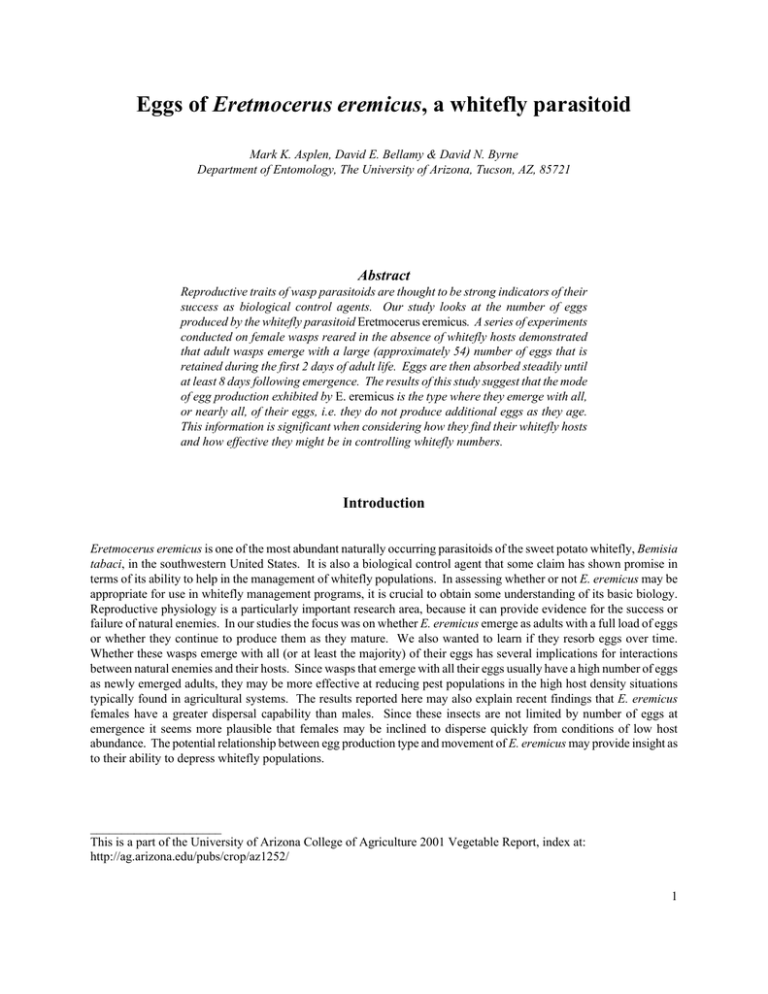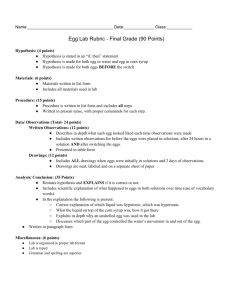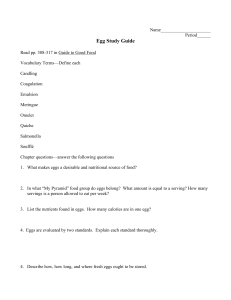Eretmocerus eremicus
advertisement

Eggs of Eretmocerus eremicus, a whitefly parasitoid Mark K. Asplen, David E. Bellamy & David N. Byrne Department of Entomology, The University of Arizona, Tucson, AZ, 85721 Abstract Reproductive traits of wasp parasitoids are thought to be strong indicators of their success as biological control agents. Our study looks at the number of eggs produced by the whitefly parasitoid Eretmocerus eremicus. A series of experiments conducted on female wasps reared in the absence of whitefly hosts demonstrated that adult wasps emerge with a large (approximately 54) number of eggs that is retained during the first 2 days of adult life. Eggs are then absorbed steadily until at least 8 days following emergence. The results of this study suggest that the mode of egg production exhibited by E. eremicus is the type where they emerge with all, or nearly all, of their eggs, i.e. they do not produce additional eggs as they age. This information is significant when considering how they find their whitefly hosts and how effective they might be in controlling whitefly numbers. Introduction Eretmocerus eremicus is one of the most abundant naturally occurring parasitoids of the sweet potato whitefly, Bemisia tabaci, in the southwestern United States. It is also a biological control agent that some claim has shown promise in terms of its ability to help in the management of whitefly populations. In assessing whether or not E. eremicus may be appropriate for use in whitefly management programs, it is crucial to obtain some understanding of its basic biology. Reproductive physiology is a particularly important research area, because it can provide evidence for the success or failure of natural enemies. In our studies the focus was on whether E. eremicus emerge as adults with a full load of eggs or whether they continue to produce them as they mature. We also wanted to learn if they resorb eggs over time. Whether these wasps emerge with all (or at least the majority) of their eggs has several implications for interactions between natural enemies and their hosts. Since wasps that emerge with all their eggs usually have a high number of eggs as newly emerged adults, they may be more effective at reducing pest populations in the high host density situations typically found in agricultural systems. The results reported here may also explain recent findings that E. eremicus females have a greater dispersal capability than males. Since these insects are not limited by number of eggs at emergence it seems more plausible that females may be inclined to disperse quickly from conditions of low host abundance. The potential relationship between egg production type and movement of E. eremicus may provide insight as to their ability to depress whitefly populations. _____________________ This is a part of the University of Arizona College of Agriculture 2001 Vegetable Report, index at: http://ag.arizona.edu/pubs/crop/az1252/ 1 Materials and Methods Wasps were obtained from a colony that came from a population of sweet potato whiteflies found on ornamental lantana. Rates of egg resorption in E. eremicus were investigated in a time series study. Approximately 600 parasitized fourth instar whitefly nymphs were removed from bean leaves and individually placed into glass vials. Vials were sealed with Parafilm and maintained under laboratory conditions. Nymphs were monitored daily. Emerging female wasps were treated in the following ways. Members of one group (mated) were paired with male parasitoids for 24 hours. E. eremicus is known to mate soon after emergence, so this exposure period was considered sufficient to ensure mating. Other wasps were members of the control group (unmated) and were not exposed to males. From these two groups, 64 mated and 64 unmated females were used. Sixteen wasps from each group were randomly placed in each of four treatments; 2, 4, 6 and 8 days after emergence. After the designated treatment time had passed, each wasp was immediately chilled and then anaesthetized with carbon dioxide to accommodate weighing. Following weighing, insects were returned to their vials and immediately frozen. A second series of experiments was conducted to investigate egg load at adult emergence and 1 d following. These treatments could not be studied in trials involving mated individuals, as 24 h exposure to males was required for mating. Since analysis of data from the first experiments indicated no significant relationship between mating status and egg number, unmated wasps could be utilized to investigate these periods. Females were dissected on glass microscope slides to count the number of eggs. This was done by pulling the strings of eggs gently apart. Results and Discussion Our results (Fig. 1) suggest that E. eremicus should be described as having a full, or nearly so, complement of eggs at emergence to adulthood. The relationship described for two other parasitoids, Encarsia formosa and Aphytis melinus, were different. These wasps, reared in conditions similar to those of this experiment, do not emerge as adults with all their eggs, but rather continue to mature eggs during the first days as adults. Resorption of eggs occurs in all three species after 2 days (E. eremicus and A. melinus) or 3 days (E. formosa). In addition, the observation that egg volume does not increase during the first few days of the time series provides supportive evidence that eggs are likely mature at when leaving the pupal stage. E. eremicus appear to resorb eggs after the first 2 days following eclosion. Resorption begins immediately following a period of parasitoid weight reduction, after which weight remains constant. This suggests that, on a diet consisting solely of honey E. eremicus may begin egg resorption 2 days following eclosion in an effort to meet demands. This explanation for resorption has been suggested previously, although neither of these studies measured weight in relation to egg numbers. Under the conditions examined here, it appears that a trade-off between weight and lifetime reproduction exists in which parasitoid fitness may be directly increased by egg resorption. A different relationship between egg load and mass might be expected in naturally occurring populations, where E. eremicus would have the ability to feed on whiteflies. This would allow them access to proteins without having to break down egg tissue. This suggests that parasitoid host feeding may be more complex than previously postulated, with a strict relationship between host feeding and egg maturation possibly being an oversimplified view. The egg number values for E. eremicus presented here differ markedly from those reported elsewhere (Fig. 1). The discovery of high egg counts in this wasp family is an important first step toward a deeper understanding of the reproductive biology of these potential agents of biological control. 2 Fig. 1. Female E. eremicus weight (squares) and number of eggs (circles) as a function of age. The dashed line represents the age separation of the two studies. The trend lines were estimated from the results. Values reported as means ± a measure of variation. . 27 62 26 58 25 54 24 50 46 23 42 22 38 21 34 20 30 19 26 18 22 17 18 16 14 15 10 0 1 2 3 4 5 6 7 8 Time (d) 3 Number of eggs Mass (micrograms) Mass and egg load in E. eremicus







